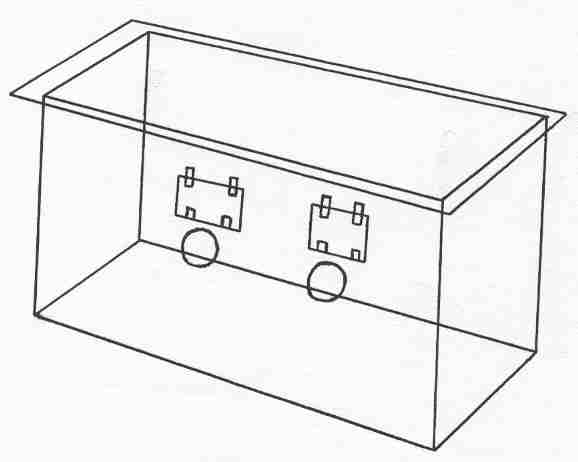

Materials - plywood, plate glass and weather stripping. Be sure and make the box out of heavy enough wood so that it won't move excessively as you move your hands around. A little movement is OK.
This is the simplest design for a sterile air transferring hand box. It is four pieces of perfectly cut rectangular plywood, painted with a water resistant coating (preferably white enamel type paint). It has no top or bottom. The box sits on a flat table that serves as the work surface. A piece of plate glass (edged for safety!!) sits flat on top. The four panels of the box must be cut perfectly square so that when they are attached, the top and bottom of the box are flat and straight which insures draft free operation. The bottom of the box must sit squarely with the table with no leaks as well as the plate glass cover. If you want, you can line the top and bottom edges of the box with weather stripping for extra security against air drafts entering.
There are two round holes for your arms. When you cut the arm holes, determine your own particular movement needs (up, down, forward and sideways within the box) and place the arm holes to facilitate reaching and manipulating things. Cut the arm holes to size so that your arms (below the elbows) will close off and seal the holes to prevent contaminating air drafts from entering as you work. Cardboard squares are taped to the front of the box over the arm holes in order to cover the holes when the sterile spray is used to sterilize the interior air (shown in up position - undo the upper pieces of tape and the covers flip down).
Number one rule: Any surfaces or utensil's to be used in direct contact with the fungus are to be first covered or protected against the sterilant. You can cover closed dishes and jars with cut pieces of acrylic plastic.
To use the box, first place the things you will be working with into the box. Any surfaces or utensils to be used in direct contact with the fungus are to be covered or protected from the sterilizing spray. You can cover petrie dishes and jars with cut pieces of acrylic plastic for extra protection if you want and then remove the covers when you want to work. Tape the cardboard squares to the front of the box to cover the arm holes which will prevent air from entering the box during sterilization.
Slightly lift the glass plate cover and spray the interior of the box with 10% laundry bleach and 90% water or some kind of Lysol spray, or for the max killing power, you can use rubbing alcohol in a spray bottle. Let the spray vapors settle a minute or two. You don't need gloves, just wash your hands and arms. Remove the tape from the bottoms of the cardboard hole covers, lift or remove cardboard hole covers and with a MINIMUM of air disturbance or draft creation, insert your hands.
Sterile jars full of media can be opened and transferred without fear of contamination. Scalpels and dissection implements can be taken into the just sterilized (sprayed) box in your hands as you insert your hands through the access holes.
Don't seal any containers after working on them in the chamber. This allows whatever chlorine gas, alcohol vapors, ect, that has gotten into the jar or dish to naturally dissipate with normal gas exchange. To accomplish this, just slightly loosen the jar lids. They can be left in the box for added protection while they are exchanging any vaporous gas with good air. After a few days, then the jars and containers can be sealed for later use.
To be sure, things can be awkward, but with a good air tight box, you can knock things around and be sloppy and still have no contamination. That is why there is no bottom to the box. After working in the box, there will be strewn all over the bottom (table top), bits of agar, fungus, grain kernels or whatever might drop off of your scalpel, spoon, fork or knife ect. With no bottom, just take off the glass plate top, lift off the box and clean the table.
You can customize the box any way your creativity allows. For instance, you can rig up little hooks and dowel hangers and nails inside the box in proximity to your hands (reach) so that you can have a safe spot to hang your dissection tools as you work (away from toxic chemical droplets of the sterilant).
The Professor has used this type of box for many years before he got a HEPA filter blower. The Professor's very first cultivation employed an old 20 gallon aquarium with a Plexiglas cover (fits in the top of the aquarium) with two arm holes. It worked great the first attempt. Then the aquarium got broke and the Professor made a big box like the one pictured above out of heavy weight particle board. It also worked great. Then the third one was made out of lightweight plywood painted with white bathroom enamel (easy to tote around the house) and that one served the Professor for years. Then the Professor got into the HEPA filter blower (high tech). But, for hobbyists, the hand box design works as well and a lot cheaper and basically fool proof (low tech) but the disadvantage is that it can be awkward, but it has its good points to be sure.